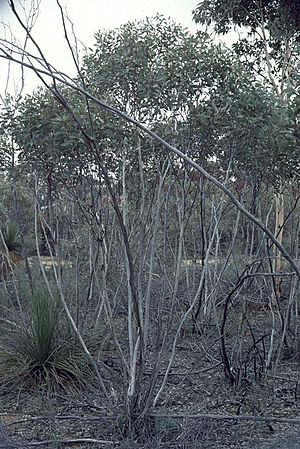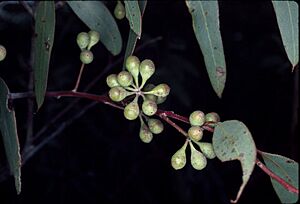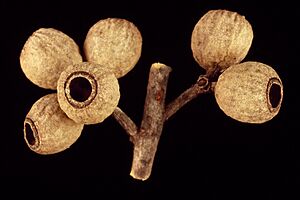Boyagin mallee facts for kids
Quick facts for kids Boyagin mallee |
|
|---|---|
 |
|
| Eucalyptus exilis near Boyagin Rock | |
| Conservation status | |
| Scientific classification | |
| Genus: |
Eucalyptus
|
| Species: |
exilis
|
The Boyagin mallee, also known as Eucalyptus exilis, is a special type of tree or shrub. It grows only in Western Australia. This plant has thin stems with smooth bark. Its leaves are shaped like a spear. It produces white flowers from buds that grow in groups of eleven. After flowering, it forms fruit shaped like a barrel or a short ball.
Contents
What Does the Boyagin Mallee Look Like?
The Boyagin mallee is a type of mallee plant. This means it has many thin stems growing from a large woody base called a lignotuber. It usually grows to be about 2 to 6 meters (6 to 20 feet) tall.
Bark and Leaves
The trunk and branches of this plant have smooth bark. It is usually whitish to pale grey, with hints of yellow underneath. This bark peels off in long, thin strips.
Young Boyagin mallee plants have stems that are square-shaped. Their leaves are oval or egg-shaped and attach directly to the stem without a stalk. These young leaves are about 5 to 7.5 centimeters (2 to 3 inches) long and 4 to 5 centimeters (1.5 to 2 inches) wide.
As the plant gets older, its leaves change. Adult leaves are a bit shiny and green on both sides. They are shaped like a spear, about 3.5 to 6.5 centimeters (1.4 to 2.5 inches) long and 0.8 to 1.5 centimeters (0.3 to 0.6 inches) wide. These adult leaves grow on a small stalk called a petiole, which is about 0.8 to 1.5 centimeters long.
Flowers and Fruit
The flower buds of the Boyagin mallee grow in groups of eleven. They are found where the leaves meet the stem. Each group of buds sits on a stalk called a peduncle, which is about 0.8 to 1.5 centimeters long. Each individual bud has its own small stalk, called a pedicel, about 0.3 to 0.7 centimeters long.
When the buds are ready, they are oval or pear-shaped. They are about 0.6 to 0.8 centimeters long and 0.4 to 0.5 centimeters wide. The top part of the bud, called the operculum, is rounded and sometimes has a small point.
The Boyagin mallee flowers between August and October. Its flowers are white. After the flowers, the plant produces a woody fruit. This fruit is shaped like a barrel or a short ball. It is about 0.8 to 1.5 centimeters long and 0.9 to 1.3 centimeters wide. The seeds inside are dark brownish-black and shaped like a pyramid.
How Was it Named?
The scientific name for the Boyagin mallee is Eucalyptus exilis. It was first officially described by a scientist named Ian Brooker. He published his description in a science journal called Nuytsia.
The second part of its scientific name, exilis, comes from a Latin word. In Latin, exilis means slender. This name was chosen because the plant has very thin stems.
Where Does the Boyagin Mallee Grow?
The Boyagin mallee grows in a few separate areas in the wheatbelt region of Western Australia. This is called a disjunct distribution, meaning its populations are not connected.
You can find it growing in areas with heathland and shrubland. It prefers to grow on rocky ridges made of a type of soil called lateritic soil, mixed with sand and loam. The three main places where it grows are near Boyagin Rock, around a town called Bindoon, and to the north-east of Mount Lesueur.
Is it Protected?
The Western Australian Government's Department of Parks and Wildlife has looked at the Boyagin mallee. They have classified it as "not threatened." This means that, for now, there are enough of these plants in the wild, and they are not in danger of disappearing.




